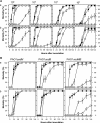Effect of superoxide dismutase gene inactivation on virulence of Pseudomonas aeruginosa PAO1 toward the silkworm, Bombyx mori
- PMID: 17220257
- PMCID: PMC1828791
- DOI: 10.1128/AEM.00981-06
Effect of superoxide dismutase gene inactivation on virulence of Pseudomonas aeruginosa PAO1 toward the silkworm, Bombyx mori
Abstract
To investigate the role of superoxide dismutase (SOD) in virulence against the silkworm, Bombyx mori, mutants of Pseudomonas aeruginosa PAO1 lacking manganese-SOD (PAO1sodM), iron-SOD (PAO1sodB), or both (PAO1sodMB) were generated. The mutants were injected into the hemocoel of B. mori. The virulence decreased in the order PAO1=PAO1sodM>PAO1sodB>PAO1sodMB. In particular, PAO1sodMB was avirulent at a dose of 10(5) cells or less. The sod double mutant PAO1sodMB was then complemented with either pSodM or pSodB in trans. In both the complemented strains, the virulence was partially restored. Of the two plasmids, pSodB contributed more to the virulence of P. aeruginosa against B. mori. The results of growth in B. mori hemolymph broth and microscopic analysis suggested that a longer lag phase and superoxide sensitivity correlated with decreased virulence in sod mutants. In conclusion, the SODs are required for full virulence of P. aeruginosa against B. mori and Fe-SOD is more important than Mn-SOD in the infection process.
Figures




Similar articles
-
Inactivation of pyocyanin synthesis genes has no effect on the virulence of Pseudomonas aeruginosa PAO1 toward the silkworm, Bombyx mori.FEMS Microbiol Lett. 2008 Jan;278(1):101-7. doi: 10.1111/j.1574-6968.2007.00982.x. Epub 2007 Nov 19. FEMS Microbiol Lett. 2008. PMID: 18031534
-
Pathogenicity of gacA mutant of Pseudomonas aeruginosa PA01 in the silkworm, Bombyx mori.FEMS Microbiol Lett. 2005 Mar 1;244(1):181-6. doi: 10.1016/j.femsle.2005.01.032. FEMS Microbiol Lett. 2005. PMID: 15727838
-
Role of nitric oxide-detoxifying enzymes in the virulence of Pseudomonas aeruginosa against the silkworm, Bombyx mori.Biosci Biotechnol Biochem. 2013;77(1):198-200. doi: 10.1271/bbb.120656. Epub 2013 Jan 7. Biosci Biotechnol Biochem. 2013. PMID: 23291757
-
Understanding of bacterial virulence using the silkworm infection model.Drug Discov Ther. 2016 Feb;10(1):30-3. doi: 10.5582/ddt.2016.01020. Drug Discov Ther. 2016. PMID: 26971552 Review.
-
Cellular recognition of foreign materials by Bombyx mori phagocytes: I. Immunocompetent cells.Dev Comp Immunol. 1982 Fall;6(4):591-9. Dev Comp Immunol. 1982. PMID: 6761180 Review.
Cited by
-
Dual Transcriptomics of Host-Pathogen Interaction of Cystic Fibrosis Isolate Pseudomonas aeruginosa PASS1 With Zebrafish.Front Cell Infect Microbiol. 2018 Nov 22;8:406. doi: 10.3389/fcimb.2018.00406. eCollection 2018. Front Cell Infect Microbiol. 2018. PMID: 30524971 Free PMC article.
-
Transcriptome profiling reveals links between ParS/ParR, MexEF-OprN, and quorum sensing in the regulation of adaptation and virulence in Pseudomonas aeruginosa.BMC Genomics. 2013 Sep 13;14:618. doi: 10.1186/1471-2164-14-618. BMC Genomics. 2013. PMID: 24034668 Free PMC article.
-
Monothiol Glutaredoxin Is Essential for Oxidative Stress Protection and Virulence in Pseudomonas aeruginosa.Appl Environ Microbiol. 2023 Jan 31;89(1):e0171422. doi: 10.1128/aem.01714-22. Epub 2022 Dec 19. Appl Environ Microbiol. 2023. PMID: 36533942 Free PMC article.
-
Requirement of the Pseudomonas aeruginosa CbrA sensor kinase for full virulence in a murine acute lung infection model.Infect Immun. 2014 Mar;82(3):1256-67. doi: 10.1128/IAI.01527-13. Epub 2013 Dec 30. Infect Immun. 2014. PMID: 24379284 Free PMC article.
-
Promise for plant pest control: root-associated pseudomonads with insecticidal activities.Front Plant Sci. 2013 Jul 31;4:287. doi: 10.3389/fpls.2013.00287. eCollection 2013. Front Plant Sci. 2013. PMID: 23914197 Free PMC article.
References
-
- Banin, E., D. Vassilakos, E. Orr, R. J. Martinez, and E. Rosenberg. 2003. Superoxide dismutase is a virulence factor produced by the coral bleaching pathogen Vibrio shiloi. Curr. Microbiol. 46:418-422. - PubMed
-
- Blondelet-Rouault, M. H., J. Weiser, A. Lebrihi, P. Branny, and J. L. Pernodet. 1997. Antibiotic resistance gene cassettes derived from the Ω interposon for use in E. coli and Streptomyces. Gene 190:315-317. - PubMed
Publication types
MeSH terms
Substances
LinkOut - more resources
Full Text Sources

